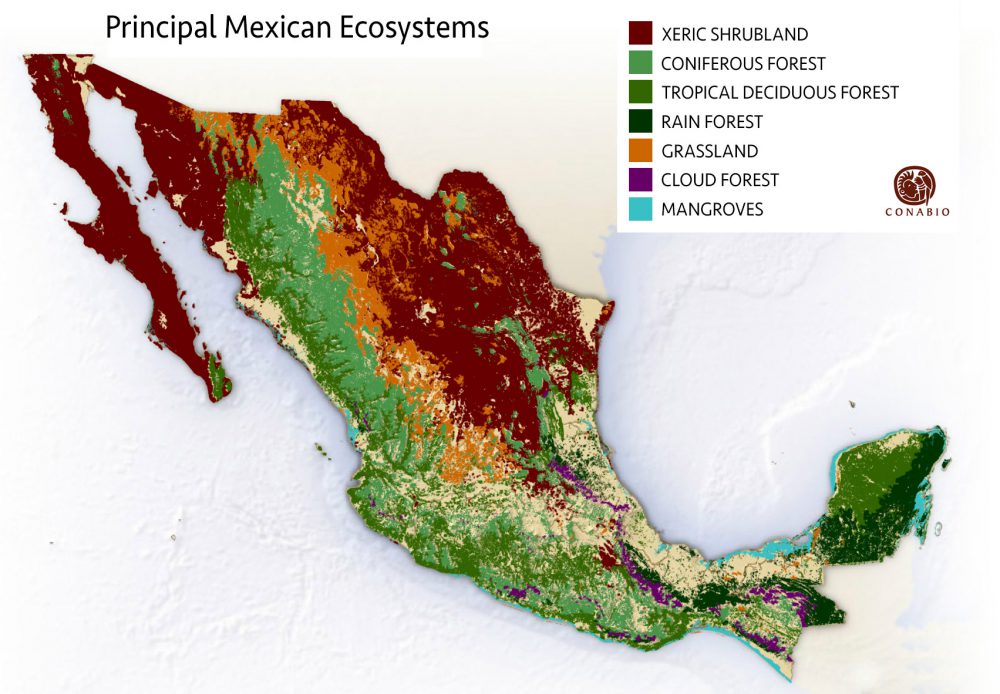For More info visit CONABIO: http://www.biodiversidad.gob.mx/ecosistemas/selvaHumeda.html
(Use translate function on the website to read in English)
Principal ecosystems in Mexico

Tropical evergreen forest (rainforest)
- Description: These are the lushest plant communities of the country consisting of a large variety of tree species that retain their foliage all year. Many trees reach heights of 30m and more. Rainforests are distributed in warm, humid climates. These are very complex ecosystems with great diversity of species.
- Distribution: Originally occupied about 9.2% of Mexican territory, but have been reduced by a half to 4.7% (91 566 km²). In Mexico rainforests can be found almost exclusively on the Atlantic slope, from southern San Luis Potosi along Tabasco and Veracruz to the south of the Yucatan Peninsula. They are also present in a narrow strip of the Pacific slope of the Sierra Madre de Chiapas, as well as smaller areas in the lower foothills of the Sierra Madre del Sur of Oaxaca and Guerrero, usually in areas below 1,200 meters above sea level.
- Climate: Regions with abundant rainfall and warm temperatures all year = plants are able to retain their foliage. The average rainfall is over 2,000 mm per year and the temperature, always greater than 18 ° C with very little variation (5 to 7 ° C). Most of the Mexican rainforests grow on limestone karst rocks. Rainfall runs off directly into subsurface cracks and surface rivers are therefore very scarce.
Spider monkey (Ateles geoffrogyi)
Howler monkey (Alouatta palliata)
White-nosed Coati (Nasua narica)
Anteater (Tamandua mexicana)
Kinkajou (Potos flavus)
Tapir (Tapirus bairdii)
Scarlet macaw (Ara macao)
Curassow (Crax rubra)
Keel-billed toucan (Ramphastos sulfuratus)
Green iguana (Iguana iguana)
Boa (Boa constrictor)
Tropical deciduous and semideciduous forest
- Description: Plant communities dominated by small trees that lose their leaves during the dry season. They are typical of warm climates with little rain. They have a unique diversity with many endemic species. They are located in very fragile areas and climatic conditions prone to desertification.
- Distribution: occupies approximately 11.7% (226, 898 square kilometers) of Mexican territory. It is distributed on the Pacific side of Mexico from southern Sonora and southwestern Chihuahua to Chiapas and continues south through Central America. There are small portions at the southern tip of the Baja California Peninsula and north of the Yucatan Peninsula. Usually found from sea level up to 1,500 m.
- Climate: develops dry climate with extreme minimum temperature of 0 °C on the coldest days, but on average varies between 20 to 29°C . The precipitation varies between 300 and 1.200 mm (1.800 maximum) with 5 to 8 dry months, usually from December to May.
For More info visit CONABIO: http://www.biodiversidad.gob.mx/ecosistemas/selvaSeca.html
(Use translate function on the website to read in English)
For More info visit CONABIO: http://www.biodiversidad.gob.mx/ecosistemas/Matorral.html
(Use translate function on the website to read in English)
Xeric shrubland
- Description: Ecosystem with thorny and deciduous elements, composed mainly of small -leaf bushes lower than 4 m. Some are characteristic for its tower -like cacti. In reality, this is the most diverse plant community in Mexico. Their composition and overall looks vary widely depending on geographic region.
- Distribution: These ecosystems cover almost a third of the country territory, especially in the North. From Tamaulipas, Nuevo León, Coahuila, Chihuahua, Durango, Zacatecas, parts of San Luis Potosí, Durango and Guanajuato. Also in Chihuahua, Sonora and Baja California. Smaller areas then also in Puebla and Oaxaca in the Valle de Tehuacán Cuicatlán.
- Climate: Dry and semi dry climates from very hot coastel regions up to fairly cooler and higher regions. They typically count with 7 to 12 dry months in the year and annual precipitation is lower than 700 mm. Mean temperatures from 12 to 26° C.
Lesser roadrunner (Geococcyx velox)
Puma (Puma concolor)
Proghorn (Antilocapra americana)
Golden eagle (Aquila chrysaetos)
Chihuahuan Fringe-toed Lizard (Uma paraphygas)
The great horned owl (Bubo virginianus)
Gila woodpecker (Melanerpes uropygialis)
Grassland
- Description: Ecosystems where grasses dominate over trees and bushes, these may be present, but they are scarce.
- Distribution: Only around 6% of the territory of Mexico is covered with grasslands. Mostly found in the north of the country in Chihuahua, Coahuila, Sonora, Durango, Zacatecas, San Luis Potosí and Jalisco. Usually found in between 1,100 and 2,500 m.
- Climate: Dry and semidry cooler regions, where temperatures range from 12 to 20 C with annual precipitation of 300 to 600 mm. Require at least moderately fertile soils with rich content of organic matter.
For More info visit CONABIO: http://www.biodiversidad.gob.mx/ecosistemas/pastizales.html
(Use translate function on the website to read in English)
For More info visit CONABIO: www.biodiversidad.gob.mx/ecosistemas/bosqueTemplado.html
Use translate function on the website to read in English)
Coniferous forest
- Description: Ecosystems with predominantly high coniferous trees. Mexican coniferous forests are home to around 7,000 species of plants. These are evergreen ecosystems composed of mostly pines, but other variants occur, such as fir forest of Central Mexico.
- Distrubution: Mostly high elevations (2,000 to 3,400 m) of Baja California and Central Neovolcanic belt, Sierra Norte of Oaxaca and northern Chiapas.
- Cllimate: Avarage annual temperatures of 12 to 23 Celsius and annual precipitation of 600 to 1,000 mm. Winter temperatures can descend to below freezing.
Cloud forest
- Description: There are many different types of cloud forest but all share the same conditions of altitude and climate. Epiphytes are abundant, up to 800 species have been described so far. Trees form several strata – levels. Very high (up to 30%) portion of its plant species can only be found here.
- Distribution: These ecosystems can be found in between 600 and 3,100 m above sea level in small sections of Sierra Madre Oriental, Sierra Norte de Chiapas and Sierra Madre de Sur (Guerrero and Oaxaca). They occupy only 1% of the national territory.
- Climate: Always humid. Most of the year shrouded in fog. Average annual temperatures of 12 to 23 Celsius with occasional freezing winter temperatures.
Resplendent quetzal (Pharomachrus mocinno)
Horned guan (Orephasis derbianus)
Blue-capped hummingbird (Eupherusa cyanophrys)
White-tailed hummingbird (Eupherusa poliocerca)
Delicate deer mouse (Habromys delicatulus)
For More info visit CONABIO: http://www.biodiversidad.gob.mx/ecosistemas/pastizales.html
(Use translate function on the website to read in English)
For More info visit CONABIO: http://www.biodiversidad.gob.mx/ecosistemas/manglares2013/manglares.html
Use translate function on the website to read in English)
Mangrove forests /Wetlands
Description: Mangrove forests are dense evergreen ecosystems comprised of trees and bushes, principally several species of mangrove, namely (Rhizophora mangle, Laguncularia racemosa, Avicennia germinans and Conocarpus erectus). Mangroves exist only in areas where tidal zones of the ocean meet freshwater courses. High productivity ecosystems with high biological diversity.
Distribution: Mangroves can be found on both Mexican coasts and can be divided into 3 zones. North Pacific (Baja California, Baja California Sur, Sonora, Sinaloa and Nayarit), Central Pacific (Jalisco, Colima and Michoacán), South Pacific (Guerrero, Oaxaca and Chiapas), Gulf of México (Tamaulipas, Veracruz and Tabasco) and Yucatán Peninsula (Campeche, Yucatán and Quintana Roo). Mexico belongs to countries with most mangroves in the world, but has suffered a significant loss due to coastal development in recent decades.
Climate: Tropical and subtropical hot climates.
